Sources of Iodine in Vegetarian Diet
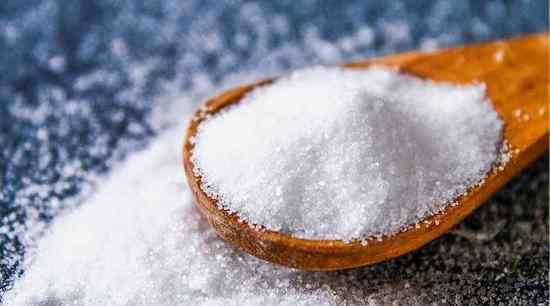
by Jack Norris, RD
Contents
- Iodine Deficiency and Excess
- Iodine Antagonists
- Excess Iodine and Disease
- Iodine and Mortality
- Iodine Sources
- Kelp Supplements
- Iodine Status of Vegans
- Urinary Iodine Concentrations of Vegans
- UIC and Urine Volume
- UIC and Creatinine
- Iodine Supplementation and UIC among Vegans
- Thyroid Hormone Levels in Vegans
- Thyroid Stimulating Hormone in Vegans
- Thyroxine (T4) in Vegans
- Thyroid Status in Adventist Health Study-2
- Conclusion for the Iodine Status of Vegans
- Recommendations
- Appendix A: Studies Measuring Iodine Intakes via Food Tables
- Appendix B. Iodine Excretion while on a Lacto-Ovo-Vegetarian Diet
- Bibliography
Iodine Deficiency and Excess
Iodine is required for a healthy thyroid. For centuries, iodine deficiency has been a problem in many regions due to a lack of iodine in the soil and food supply (Dasgupta, et al.).
Iodine deficiency among those pregnant and breastfeeding can inhibit brain development in the fetus and infant. Both too much and too little iodine can result in hypothyroidism leading to an enlarged thyroid gland, known as a goiter.
In adults, hypothyroidism can lead to mental impairment, apathy, fatigue, weight gain, cold intolerance, constipation, and hair loss (British Thyroid Foundation, 2019; Linus Pauling Institute, 2015; National Institutes of Health, 2020). A systematic review found that subclinical hypothyroidism is associated with an increased risk of depression (RR 2.35, 95% CI 1.84 to 3.02) (Loh, 2019).
Excess iodine can also result in hyperthyroidism, which can cause weight loss, tachycardia (high pulse rate), muscle weakness, skin warmth, and hair loss (British Thyroid Foundation, 2019; Linus Pauling Institute, 2015). There may be a connection between excess iodine and acne (Arbesman, 2005; Danby, 2007).
Iodine Antagonists
Soy, flax seeds, and raw cruciferous vegetables (broccoli, Brussels sprouts, cauliflower, and cabbage) contain goitrogens that counteract iodine (NIH, 2020). In large amounts, or combined with iodine deficiency, goitrogens can exacerbate iodine deficiency or cause a goiter.
Theoretically, consuming large amounts of goitrogens could have a negative impact even when iodine intake is adequate; however, we haven't found evidence of this except in people who are exposed to unusually high amounts of goitrogens, such as those whose diets are largely based on cassava root (Chandra Amar, 2015).
Excess Iodine and Disease
Excess iodine can cause either hypothyroidism or hyperthyroidism. Often, the condition is due to iodine toxicity from medications or medical procedures, and is temporary; though in some cases it persists (Leung, 2014). Farebrother, et al. (2019) point out:
- Most adults without underlying thyroid disease and living in iodine-sufficient areas can tolerate a chronic excess iodine intake of up to 2 g/day without clinical effect.
- High iodine intakes are a particular problem in populations with inadequate iodine that begin a supplementation program; intakes as low as 300 µg/day can trigger hyperthyroidism in individuals who are susceptible .
- The prevention of iodine deficiency through iodine fortification generally outweighs the risks of iodine excess, but monitoring should be conducted.
Dasgupta, et al. report that Japan has a high iodine intake ranging between 700 and 3,200 μg/d with excellent thyroid health, suggesting that excess iodine might be harmful only in areas where the population has adapted to low iodine intakes.
Iodine and Mortality
A U.S. study estimated mortality rates according to urinary iodine concentration (UIC), utilizing a nationally representative sample of 12,264 adults, aged 20–80 years, enrolled in the National Health and Nutrition Examination Survey (NHANES) III from 1988 to 1994 (Inoue, 2018). The participants were followed for 19.2 years, and those with very high iodine levels had a higher rate of mortality while those with a very low UIC did not.
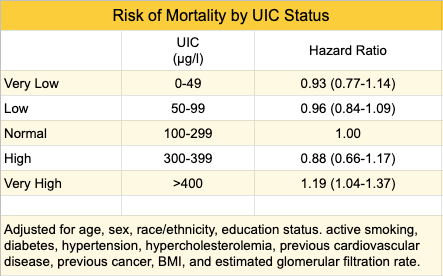
Iodine Sources
Iodine is consistently found in only a few foods: iodized salt, seaweeds, sea animals, and dairy products. Cows are given iodine supplements, and iodine in cleaning solutions are transferred to the milk.
In plant foods, iodine is found inconsistently depending on the iodine content of the soil; food grown near the ocean tends to be higher in iodine. Unfortified commercial plant milks are very low in iodine (Ma, 2016; Bath, 2017). Plant milks fortified with iodine have an iodine content similar to cow's milk but few are iodine-fortified (Bath, 2017; Vance, 2017).
If someone regularly eats seaweed (multiple times a week), they'll likely obtain adequate iodine; however, the availability of iodine from seaweed is variable and it can provide excessive amounts.
Kelp Supplements
Most iodine supplements are simply tablets made from kelp. Being a seaweed, kelp likely contains at least small amounts of arsenic. There are some very rare cases in which people taking kelp supplements have developed symptoms of arsenic toxicity (Amster, 2007).
A survey of kelp supplements in the U.S. found that 8 out of 9 batches contained some level of arsenic (Amster, 2007), while a survey in the U.K. of imported seaweed found very little arsenic in kelp (Rose, 2007). In contrast, a 2017 ConsumerLabs.com report found arsenic contamination in only 1 of 6 supplements in the U.S., but they found excessive iodine in many of the supplements.
In their 2019 review, Farebrother et al. say, "A survey of the U.S. prenatal multivitamins found significant discordance between label information and laboratory assay; 25 brands containing kelp contained between 33 and 610 µg per daily dose, the latter being almost three times the 220 µg recommended daily intake. This may be explained by the natural variations in kelp iodine content, and for this reason, kelp supplements should generally be avoided, and potassium iodide should be used in vitamin preparations."
Iodine Status of Vegans
Research has raised concerns about the iodine status of vegetarians and, especially, vegans. In this section, we examine that research to determine how much concern is warranted.
Urinary Iodine Concentrations of Vegans
Average urinary iodine concentration (UIC) is used to determine the iodine status of a population. The World Health Organization (WHO) suggests these categories (WHO, 2007):
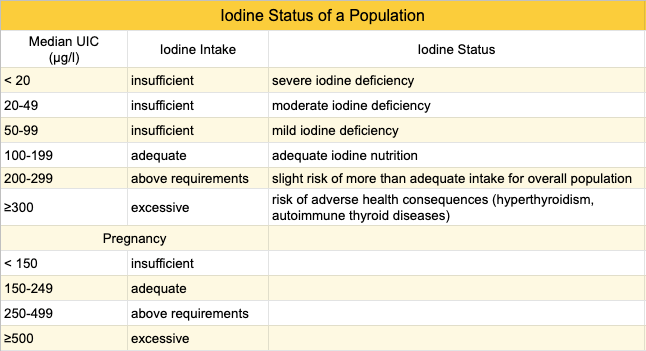
But there are problems with using the WHO's cutoffs to determine the iodine adequacy of an adult population. Iodine status has primarily been studied in school-age children, and Zimmermann and Andersson (2012) point out that the WHO extrapolated adequate UIC levels for populations of school-age children to adults; they provide evidence that an adequate average UIC for an adult population is about 60 to 70 µg/l.
There's also high day-to-day variability in iodine intake and water consumption for any individual, with fasting samples and morning samples giving lower UIC values (Soldin, 2002). In order to compensate for the various issues with determining UIC, it's recommended that 500 samples (not necessarily people) be used to determine the UIC for a population (Zimmermann, 2012). In contrast, a total of 360 vegans have been included in all studies, with 212 being the highest number of samples in any individual study (Schüpbach, 2017). The UIC sampling methods and the number of people included in studies on vegans are listed in the Summary tab of Iodine Supplementary Material for VeganHealth.
The chart below includes studies measuring the UIC of vegetarians and vegans. The typical UIC of vegans, depicted by the solid green line, is far below the 100 µg/l that the WHO recommends (the dotted lines are explained in the next section, UIC and Urine Volume).

Table Notes: LOV – lacto-ovo-vegetarian. Sources (from left to right): Finland: Elorinne, 2016; U.K.: Lightowler, 1998; Germany: Weikert, 2020; Norway: Henjum, 2018; Norway: Groufh-Jacobsen, 2020; Norway: Brantsaeter, 2018; Switzerland: Schüpbach, 2017; Slovakia: Krajcovicová-Kudlácková, 2003; Boston: Leung, 2011. (Spreadsheet)
UIC and Urine Volume
None of the studies measuring the UIC of vegans adjusted for urine volume, which could be higher for vegans due to plant foods containing more water, resulting in artificially low UIC measurements. One study has measured urine volume of people while on a lacto-ovo-vegetarian diet (Siener, 2002). In the table below, their data was used to create a factor to adjust the UIC of lacto-ovo-vegetarians and vegans for urine volume. The dotted lines in the Diet Type vs. UIC figure (above) represent what the UIC for lacto-ovo-vegetarians and vegans might be if they were adjusted for urine volume, though this should be considered purely hypothetical.
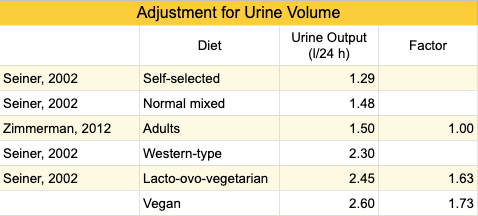
Table notes: 10 men were placed on four different diets to determine the impact of diet modifications on urine composition and the risk of calcium oxalate crystallization. The men consumed a self-selected diet for 14 days, and then three different diets for a period of 5 days each: a Western-type diet "representative of usual dietary habits," a normal mixed diet, and a lacto-ovo-vegetarian diet. For the normal mixed diet, urine output was 1.5 l/day, which is often cited as the daily urine output for adults (Zimmermann, 2012). During the lacto-ovo-vegetarian phase, urine output was 2.5 l/day due to the higher water content of fruits and vegetables. To adjust for the likely higher water content of a vegan diet, the factor for vegans is based on the same difference in urine output between vegans and lacto-ovo-vegetarians as was found between lacto-ovo-vegetarians and the Western-type diet.
UIC and Creatinine
Soldin (2002) reports that urinary iodine to creatinine ratio (UI/Cr) is considered a more reliable measurement of iodine excretion than UIC measurements based on urine volume. Only one study of vegans included the UI/Cr ratio (Brantsaeter, 2018). The UIC ratio of meat-eaters and lacto-ovo-vegetarians to vegans is higher when based on urine volume than on creatinine (see table below), which provides more evidence that urine volume could be artificially lowering the UIC of vegans. On the other hand, there's evidence that vegans have lower creatinine levels than meat-eaters (Lindqvist, 2020) which would counteract these ratios, making it hard to assess the UIC of vegans using creatinine.
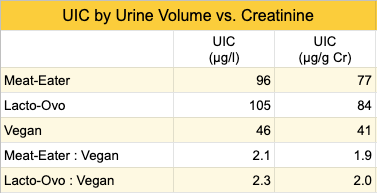
Iodine Supplementation and UIC among Vegans
An interesting phenomenon appears when graphing the reported iodine intakes versus UIC in the studies on vegans that reported both: There's actually an inverse association between iodine intakes and UIC.

For reference, the United States dietary recommended allowance (RDA) for iodine is 150 µg/day for adults.
Limiting the studies to vegans whose intakes were measured but who weren't adding iodine through seaweed or supplements produces a similar result as seen in the table and graph below.

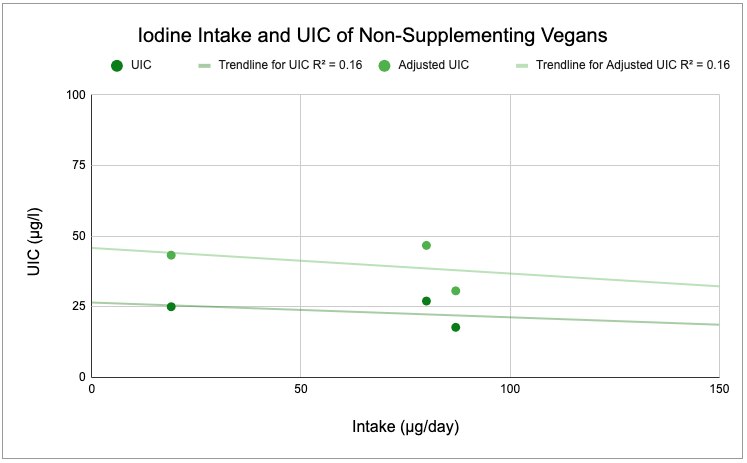
The study by Lightowler and Davies (1998) is worth a closer look. They used a a chemical analysis of duplicate portions of 4 days of food and urine to determine iodine intake and urinary iodine output of vegans in the U.K. They found that of the 30 vegans, 22 weren't taking supplements or seaweed, 3 were taking seaweed, and 7 were taking supplements. The chart below shows their intakes and urinary iodine excretion. Iodine intakes for those eating seaweed were 866 µg/day. The results suggest that either the iodine in the seaweed wasn't bioavailable, the intakes were misreported, or the iodine had cleared by the time the spot test was conducted. Adjusting for higher urine volume (as explained in UIC and Urine Volume) increases the UIC for supplementing vegans to the 60 to 70 µg/l range recommended for an adult population by Zimmermann and Andersson (2012).
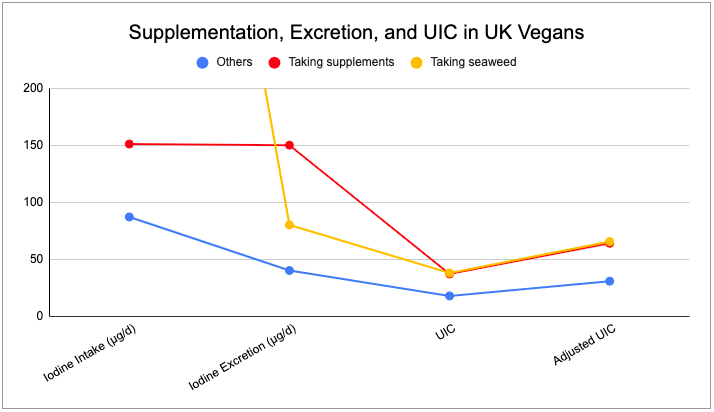

Thyroid Hormone Levels in Vegans
With regard to the iodine status of individuals, Zimmermann and Andersson (2012) point out that UIC isn't an appropriate indicator:
A common mistake is to assume that all subjects with a spot UIC <100 mg/L are iodine deficient. But dietary iodine intake and therefore UIC are highly variable from day to day. In iodine-sufficient countries where most iodine intake comes from iodized salt, UIC (both spot and 24-h urine collections) show an individual day-to-day variation of 30–40%.
Due to the limitations of assessing the iodine status of individuals based on UIC, we'll turn our focus to the thyroid hormones.
Thyroid Stimulating Hormone in Vegans
Less studied in vegans than UIC, but arguably more important, is thyroid-stimulating hormone (TSH). Although TSH is considered a poor indicator of iodine status, it's a more direct indicator of thyroid health which is the objective of maintaining a healthy iodine status.
Normal TSH levels are typically considered to be between 0.5 to 5.0 mIU/l. In general, a higher TSH level is a sign of hypothyroidism in which more TSH is signaling the thyroid to produce the thyroid hormones T3 and T4. A lower TSH level is a sign of hyperthyroidism in which the body is not signaling the thyroid to produce more hormone because there's already too much.
There are four studies reporting TSH levels in vegans (Key, 1992; Leung, 2011; Rauma, 1994; Weikert 2020). Except for a caveat regarding Key et al. (explained in the chart notes), the average TSH levels of the total of 150 vegans in these studies were, respectively, 2.2, 1.1, 2.1, and 2.4 mlU/l; all well within the normal range.
Using the best data we have and except when iodine intake is excessive, the chart below shows normal TSH levels for a range of usual iodine intakes among vegans.
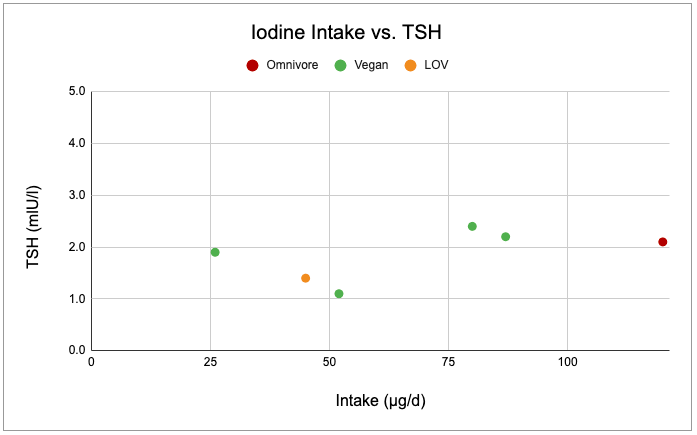
Chart notes: An iodine intake of 87 µg was estimated for the vegans in Key et al. who weren't supplementing. This was based on a direct measurement of dietary iodine conducted in another study on U.K. vegans who also weren't supplementing (Lightowler, 1998). The U.K. has never had a program of iodine fortification (Vanderpump and Bath, 2019; Patience, 2018) and so the vegan intakes should have been similar in the two studies, but regardless of the actual iodine intake of the vegans in Key et al., their average TSH level was normal.
Key et al. excluded three vegans from the average TSH measurement due to reporting taking kelp. These three vegans had very high TSH measurements of 11.3, 13.4, and 26.4 mlU/l and are excluded from the graph above of Iodine Intake vs. TSH. For these participants, there's a small chance of reverse causality such that some were supplementing with iodine in response to a diagnosis of a high TSH. The remaining vegans in Key et al. reported taking no iodine supplements; two of these had elevated TSH levels of 5.3 and 8.3 mlU/l (and are included in the graph above).
Rauma et al. studied a small group of long-term, vegan raw foodists in Finland, many of whom had adopted the diet to treat medical conditions. Chemical analysis of duplicate food portions revealed an intake of 26 µg per day. All vegans had a TSH of under 4.0 except the vegan with the highest urinary iodine of 1,700 µg/day who had a TSH of 5.0 mlU/l (laboratory reference range was to 0.2–4.0 mlU/l).
One exception to the normal TSH levels among non-seaweed-eating vegans is reported in an obscure abstract (Crane, 1992) that I couldn't locate, but that is described by Remer et al. The study was of vegans in the United States who used only non-iodized sea salt and had significantly reduced serum iodine concentrations; 25% had clearly elevated TSH levels and 12% had developed hypothyroidism.
Thyroxine (T4) in Vegans
The thyroid produces two hormones that regulate metabolism: triiodothyronine (T3) and thyroxine (T4). The thyroid mainly produces T4 (Farebrother, 2019). The half-life of T4 is 5 to 7 days, while the half-life of T3 is only 1 day (Medscape, 2016).
In the three studies measuring thyroid hormone levels of vegans, only one vegan had a T4 level below the reference range, and that was a participant in Key et al.'s study who was supplementing with seaweed (table below). Note that Leung et al. excluded participants who had thyroid disease, so only undiagnosed thyroid disease would have been detected in these subjects.

Thyroid Status in Adventist Health Study-2
The most direct way to determine the thyroid status of vegans is to measure their rates of thyroid disease. The data is limited, but we have reports from the Adventist Health Study-2 measuring the prevalence of hypothyroidism and hyperthyroidism.
The prevalence of hypothyroidism among Adventist Health Study-2 participants from the U.S. and Canada was reported both cross-sectionally and prospectively after about 4-6 years of follow-up (Tonstad, 2013). Lacto-ovo-vegetarians were more likely to have been treated for hypothyroidism in the previous year in the cross-sectional arm, while vegans had a trend towards less hypothyroidism in the prospective arm.
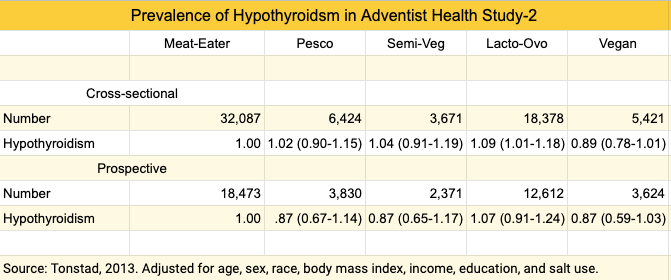
According to the authors, "While vegan diets are associated with lower body weight, which may protect against hypothyroidism, the lower risk among vegans existed even after controlling for [body mass index] and potential demographic confounders." It's not clear why lacto-ovo-vegetarians would have fared worse than meat-eaters. Adding salt to foods daily or more often than daily (compared to less than weekly) was associated with increased hypothyroidism among the entire population; this finding couldn't be readily explained.
The Adventist Health Study-2 released a report measuring the prevalence of hyperthyroidism (Tonstad, 2015). Compared to meat-eaters, vegans had a similar prevalence of reporting having had hyperthyroidism in the previous year, though only half the prevalence of being treated for it.

Conclusion for the Iodine Status of Vegans
Without supplementation or seaweed, vegans generally have a low iodine intake. Studies of vegans also show them to have lower UIC than omnivores and typically well below the threshold of 100 µg/l that the WHO recommends for a population.
There are three potential problems with using UIC as a marker for the iodine status of adult vegans: 1) the WHO UIC threshold levels are likely too high for adult populations, 2) vegans may have a higher urine volume, and 3) there is a much lower number of UIC samples in studies of vegans than what is recommended. Taken together, UIC measurements have likely exaggerated estimates of iodine deficiency among vegans.
Increasing iodine intake among vegans does little to improve their UIC, and aiming for an adequate UIC, as defined by the WHO, might be a futile or even counterproductive strategy.
Direct markers of thyroid health, TSH and T4 levels, or a diagnosis of hypothyroidism or hyperthyroidism, tend to be normal in vegans, except in some cases of supplementation with seaweed or kelp supplements.
Recommendations
The United States RDA for iodine for adults is 150 µg, with an upper limit of 1,100 µg. Although most adults can safely metabolize 1,100 µg, and even more, it's prudent not to supplement beyond the RDA.
Ideally, we'd only recommend supplementing with enough iodine to make up for any difference between usual vegan intakes and the RDA, but we have little data on iodine intakes in U.S. vegans. In the one study on U.S. vegans, Leung et al. (2011) didn't assess iodine intake, though 24 of the 62 vegans were taking a multivitamin with iodine, and two were taking either kelp or an iodine supplement. This group had the highest UIC that's been measured to date among vegans.
When you consider that 1) Zimmermann and Andersson report that in healthy adults the mean daily turnover of iodine is approximately 95 µg, 2) without supplementation, vegan iodine intakes across all countries range from 20 to 90 µg/day, and 3) research has provided little evidence of vegans showing clinical signs of iodine deficiency, it would seem likely that supplementing with an additional 100 µg/day would be plenty for vegan adults. However, without more direct research assessing vegan iodine needs, recommending less than the RDA could be risky, especially for non-adults, or for people considering becoming pregnant or who are pregnant or breastfeeding.
If salt is iodized, it will say so on the package. Although iodized salt can sometimes contain higher or lower amounts of iodine than advertised on the label (Dasgupta, 2008), salt iodization is viewed as one of the safest and most effective methods for achieving iodine sufficiency across a population and is not generally considered to be a source of excess iodine (Leung, 2014). Dasgupta et al. found that the iodine on the surface of salt may be lost to oxidation and that humidity can lead to some iodine loss from salt, so it's best to keep the container sealed and, if you live in a humid environment, store the salt in the refrigerator.
In the United States, salt is fortified with 100 µg of iodine per one-third teaspoon (which provides 774 mg of sodium). Salt in commercial and processed foods is usually not iodized (Dasgupta, 2008), and sea salt doesn't contain appreciable amounts of iodine unless fortified.
Vegans who don't meet their iodine needs by way of table salt should opt for a multivitamin or supplement containing potassium iodide. When purchasing, be aware that many stand-alone potassium iodide supplements are intended to block radiation and are measured in milligrams (mg) rather than micrograms (abbreviated as µg or mcg) and can be many times the upper limit.
We recommend not relying on kelp supplements for iodine, but if someone has been taking a multivitamin with kelp, the risks are probably not high enough to discard them; when possible, opt for potassium iodide instead of kelp.
For the U.S. RDA for various age groups, please see Daily Needs.
Appendix A: Studies Measuring Iodine Intakes via Food Tables
Although measuring iodine intakes via food tables is of questionable value due to high variability, for completeness this table lists the studies since 2015 that aren't included in the above article.
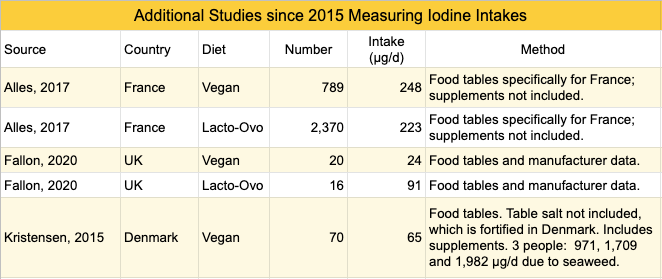
Appendix B. Iodine Excretion while on a Lacto-Ovo-Vegetarian Diet
An experimental study in Germany placed 6 healthy adults on four separate diets for 5 days each, separated by a 9 day washout period (Remer, 1999). The diets were: 1) a normal omnivorous diet moderate in protein (ND), 2) a normal omnivorous diet high in protein (P), 3) a lacto-ovo-vegetarian diet (LOV), and 4) the ND diet again. They asked the participants not to use iodized table salt and to avoid iodine-rich foods in order to obtain a representative iodine content.
A chemical analysis revealed low amounts of iodine: 15.6 µg/day for the LOV and 35.2 µg/day for the ND. Urinary iodine output was 36.6 µg/day for the LOV compared to 50.2 µg/day for the ND.
The authors conclude that thyroid iodine losses must have contributed to the urinary iodine output and that a steady metabolic state had not been achieved. At the time, Germany was still experiencing endemic goiter with about 50% of the population having enlarged thyroid glands (Hampel, 1995). Subsequently, Germany initiated an iodized salt program (Khattak, 2016).
Bibliography
Last updated January 2021
Allès B, Baudry J, Méjean C, Touvier M, Péneau S, Hercberg S, Kesse-Guyot E. Comparison of Sociodemographic and Nutritional Characteristics between Self-Reported Vegetarians, Vegans, and Meat-Eaters from the NutriNet-Santé Study. Nutrients. 2017 Sep 15;9(9):1023.
Amster E, Tiwary A, Schenker MB. Case report: potential arsenic toxicosis secondary to herbal kelp supplement. Environ Health Perspect. 2007 Apr;115(4):606-8. Epub 2007 Jan 18. Follow-up letters to the editor.
Appleby PN, Thorogood M, Mann JI, Key TJ. The Oxford vegetarian study: an overview. Am J Clin Nutr 1999 Sep;70(3 Suppl):525S-531S. Not cited.
Arbesman H. Dairy and acne–the iodine connection. J Am Acad Dermatol. 2005 Dec;53(6):1102.
Brantsaeter AL, Knutsen HK, Johansen NC, et al. Inadequate iodine intake in population groups defined by age, life stage and vegetarian dietary practice in a Norwegian convenience sample. Nutrients. 2018 Feb 17;10(2).
Bath SC, Hill S, Infante HG, Elghul S, Nezianya CJ, Rayman MP. Iodine concentration of milk-alternative drinks available in the UK in comparison with cows' milk. Br J Nutr. 2017 Oct;118(7):525-532.
British Thyroid Foundation. Hair loss and thyroid disorders. 2019. Accessed January 9, 2021.
Chandra Amar K. Iodine, Thiocyanate and the Thyroid. Biochem Pharmacol (Los Angel) 2015;4:3. (PDF)
Chung HR. Iodine and thyroid function. Ann Pediatr Endocrinol Metab. 2014 Mar;19(1):8-12. Not cited.
Crane MG, Mullen T, Lukens R. Iodine status of total vegetarians. Second International Congress on Vegetarian Nutrition (Abstract) Arlington, Virginia, USA, 1992. Could not locate.
Danby FW. Acne and iodine: reply. J Am Acad Dermatol. 2007 Jan;56(1):164-5.
Dasgupta PK, Liu Y, Dyke JV. Iodine nutrition: iodine content of iodized salt in the United States. Environ Sci Technol. 2008 Feb 15;42(4):1315-23.
Draper A, Lewis J, Malhotra N, Wheeler E. The energy and nutrient intakes of different types of vegetarian: a case for supplements? Br J Nutr. 1993 Jan;69(1):3-19. Not cited. Provided nutrient intakes but superseded by more recent research.
EUFIC (European Food Information Council). Iodine deficiency and iodine rich foods to solve the problem. Updated March 27, 2019. Accessed January 28, 2020.
Eveleigh ER, Coneyworth LJ, Avery A, Welham SJM. Vegans, Vegetarians, and Omnivores: How Does Dietary Choice Influence Iodine Intake? A Systematic Review. Nutrients. 2020;12(6):E1606. Not cited.
Fallon, N.; Dillon, S.A. Low Intakes of Iodine and Selenium Amongst Vegan and Vegetarian Women Highlight a Potential Nutritional Vulnerability. Front Nutr. 2020, 7, 72.
Farebrother J, Zimmermann MB, Andersson M. Excess iodine intake: sources, assessment, and effects on thyroid function. Ann N Y Acad Sci. 2019 Jun;1446(1):44-65.
Elorinne AL, Alfthan G, Erlund I, Kivimäki H, Paju A, Salminen I, Turpeinen U, Voutilainen S, Laakso J. Food and Nutrient Intake and Nutritional Status of Finnish Vegans and Non-Vegetarians. PLoS One. 2016 Feb 3;11(2):e0148235. Erratum in: PLoS One. 2016;11(3):e0151296.
Groufh-Jacobsen S, Hess SY, Aakre I, Folven Gjengedal EL, Blandhoel Pettersen K, Henjum S. Vegans, Vegetarians and Pescatarians Are at Risk of Iodine Deficiency in Norway. Nutrients. 2020 Nov 20;12(11):3555.
Hampel R, Külberg T, Klein K, Jerichow JU, Pichmann EG, Clausen V, Schmidt I. Strumaprävalenz in Deutschland grösser als bisher angenommen [Goiter incidence in Germany is greater than previously suspected]. Med Klin (Munich). 1995 Jun 15;90(6):324-9. Abstract.
Henjum S, Brantsæter AL, Kurniasari A, Dahl L, Aadland EK, Gjengedal ELF, Birkeland S, Aakre I. Suboptimal Iodine Status and Low Iodine Knowledge in Young Norwegian Women. Nutrients. 2018 Jul 21;10(7):941.
Inoue K, Leung AM, Sugiyama T, Tsujimoto T, Makita N, Nangaku M, Ritz BR. Urinary Iodine Concentration and Mortality Among U.S. Adults. Thyroid. 2018 Jul;28(7):913-920.
Key, T. J. A., Thorogood, M., Keenan, J. and Long, A. Raised thyroid stimulating hormone associated with kelp intake in British vegan men. Journal of Human Nutrition and Dietetics, 1992;(5):323–326.
Khattak RM, Ittermann T, Nauck M, Below H, Völzke H. Monitoring the prevalence of thyroid disorders in the adult population of Northeast Germany. Popul Health Metr. 2016 Nov 8;14:39.
Krajcovicová-Kudlácková M, Bucková K, Klimes I, Seboková E. Iodine deficiency in vegetarians and vegans. Ann Nutr Metab. 2003;47(5):183-5.
Kristensen NB, Madsen ML, Hansen TH, Allin KH, Hoppe C, Fagt S, Lausten MS, Gøbel RJ, Vestergaard H, Hansen T, Pedersen O. Intake of macro- and micronutrients in Danish vegans. Nutr J. 2015 Oct 30;14:115.
Leung AM, Braverman LE, Pearce EN. History of U.S. iodine fortification and supplementation. Nutrients. 2012 Nov 13;4(11):1740-6. Not cited.
Leung AM, Braverman LE. Consequences of excess iodine. Nat Rev Endocrinol. 2014 Mar;10(3):136-42.
Leung AM, Lamar A, He X, Braverman LE, Pearce EN. Iodine Status and Thyroid Function of Boston-Area Vegetarians and Vegans. J Clin Endocrinol Metab. 2011 May 25.
Lightowler HJ, Davies GJ. Iodine intake and iodine deficiency in vegans as assessed by the duplicate-portion technique and urinary iodine excretion. Br J Nutr. 1998 Dec;80(6):529-35.
Lindqvist HM, Rådjursöga M, Torstensson T, Jansson L, Ellegård L, Winkvist A. Urine Metabolite Profiles and Nutrient Intake Based on 4-Day Weighed Food Diary in Habitual Vegans, Vegetarians, and Omnivores. J Nutr. 2020 Feb 11:nxaa019.
Loh HH, Lim LL, Yee A, Loh HS. Association between subclinical hypothyroidism and depression: an updated systematic review and meta-analysis. BMC Psychiatry. 2019 Jan 8;19(1):12.
Linus Pauling Institute. Micronutrient Information Center. Iodine. Reviewed August 2015. Accessed January 14, 2021.
Ma W, He X, Braverman L. Iodine content in milk alternatives. Thyroid. 2016 Sep;26(9):1308-10
Medscape. Irizarry L. Thyroid Hormone. Updated: Oct 12, 2016.
National Institutes of Health (NIH) Office of Dietary Supplements. Iodine Fact Sheet for Health Professionals. Updated May 1, 2020. Accessed July 3, 2020.
Patience S. Iodine deficiency: Britain's hidden nutrition crisis. Independent Nurse. June 8, 2018. Accessed January 12, 2021.
Pennington JA. A review of iodine toxicity reports. J Am Diet Assoc. 1990 Nov;90(11):1571-81. Not cited.
Rauma A-L, Törmälä M-L, Nenonen M, Hänninen O. Iodine status in vegans consuming a living food diet. Nutrition Research. 1994;14(12):1789-95.
Remer T, Neubert A, Manz F. Increased risk of iodine deficiency with vegetarian nutrition. Br J Nutr. 1999 Jan;81(1):45-9.
Rose M, Lewis J, Langford N, Baxter M, Origgi S, Barber M, MacBain H, Thomas K. Arsenic in seaweed–forms, concentration and dietary exposure. Food Chem Toxicol. 2007 Jul;45(7):1263-7.
Schüpbach R, Wegmüller R, Berguerand C, Bui M, Herter-Aeberli I. Micronutrient status and intake in omnivores, vegetarians and vegans in Switzerland. Eur J Nutr. 2017 Feb;56(1):283-293.
Siener R, Hesse A. The effect of different diets on urine composition and the risk of calcium oxalate crystallisation in healthy subjects. Eur Urol. 2002 Sep;42(3):289-96.
Soldin OP. Controversies in urinary iodine determinations. Clin Biochem. 2002 Nov;35(8):575-9.
Tonstad S, Nathan E, Oda K, Fraser GE. Prevalence of hyperthyroidism according to type of vegetarian diet. Public Health Nutr. 2015 Jun;18(8):1482-7.
Tonstad S, Nathan E, Oda K, Fraser G. Vegan diets and hypothyroidism. Nutrients. 2013 Nov 20;5(11):4642-52.
Weikert C, Trefflich I, Menzel J, Obeid R, Longree A, Dierkes J, Meyer K, Herter-Aeberli I, Mai K, Stangl GI, Müller SM, Schwerdtle T, Lampen A, Abraham K. Vitamin and Mineral Status in a Vegan Diet. Dtsch Arztebl Int. 2020 Aug 31;117(35-36):575-582.
World Health Organization (WHO). Assessment of iodine deficiency disorders and monitoring their elimination. A guide for Programme Managers, Third edition. 2007.
Vance K, Makhmudov A, Jones RL, Caldwell KL. Re: "Iodine Content in Milk Alternatives" by Ma et al. (Thyroid 2016;26:1308-1310). Thyroid. 2017 May;27(5):748-749. [letter]
Vanderpump M. Bass S. Historical iodine status in the UK. The UK Iodine Group. Updated April 2019. Accessed January 12, 2021.
Zimmermann MB, Andersson M. Assessment of iodine nutrition in populations: past, present, and future. Nutr Rev. 2012 Oct;70(10):553-70.
Sources of Iodine in Vegetarian Diet
Source: https://veganhealth.org/iodine/
0 Response to "Sources of Iodine in Vegetarian Diet"
Post a Comment